Release Date :
Reference Number :
2018-032
Explanatory Notes
| Data on marriages presented in this release were obtained from the Certificates of Marriage (Municipal Form No. 97) that were registered at the Office of the City/Municipal Civil Registrars all throughout the country and forwarded to the Philippine Statistics Authority. Information presented include registered marriages which occurred from January to December 2016. Figures presented are not adjusted for under registration. Marriages of Filipinos abroad which were reported to the Philippine Foreign Service Posts are presented in a separate report. |
Erratic trend in marriages
In a span of 10 years, the reported number of marriages decreased by 14.4 percent from 2007 to 2016.
However, the number of registered marriages showed a generally decreasing trend from 2007 to 2016, but with speed of decrease varying for figures 2007-2012, 2012-2016 with shifts in level in 2009, 2012 and in 2015. (See Figure 1 and Table 1)
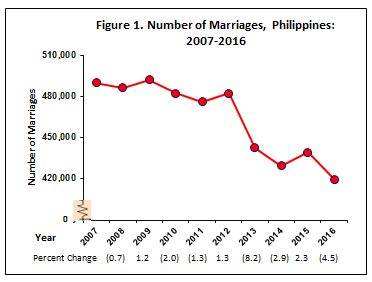
Highest number of marriages in CALABARZON
In 2016, Region IV-A recorded the highest number of registered marriages, which accounted for 13.0 percent of the total marriages. It was followed by National Capital Region (NCR) (12.7% ) and Region III (11.8% ) with the rank second and third, respectively. These regions were consistently in the top three for the past five years.
Furthermore, Region V showed the highest percent change of increase (1.8% ) from 2015 to 2016. On the other hand, NCR had the highest percent change of decrease (13.0% ). (See Figure 2 and Table 2)
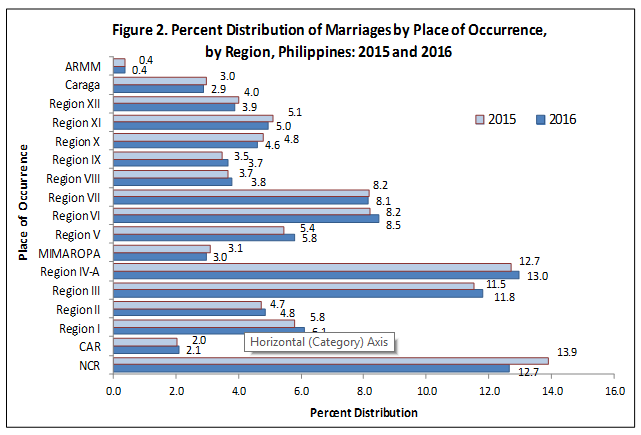
Most number of couples married in April
The top three months with recorded high number of marriages in 2016 occurred in April (52,587 or 12.5% ), February (12.3% ) and May (10.8% ). But November was the least liked month for marriage, recording the lowest number of 20,875 marriages or 5 percent . (See Table 3)
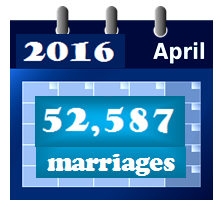
Women married younger than men
The median age of the women that got married in 2016 was two years lower than the median age of their male counterparts. This was consistently observed in the past three years.
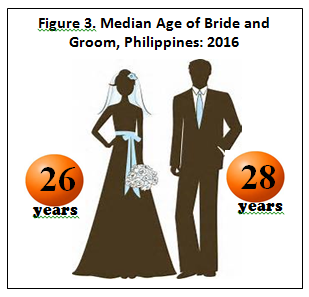
Most brides married between ages 20-24 years
About one-third of the brides married at age group 20-24 (139,067 or 33.1%) while grooms at age group 25-29 (149,187 or 35.6% ).
Meanwhile, marriages involving teenage brides were four times more than teenage grooms. It was also observed that there were some marriages involving adolescents under 15 years old. (See Figure 4 and Table 4)
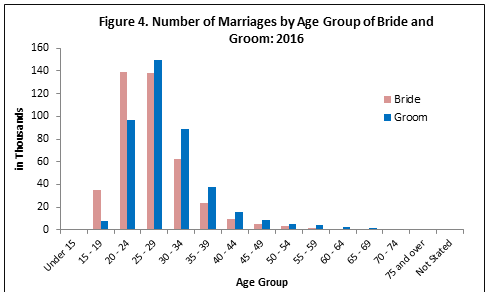
Four out of ten marriages contracted through civil rites
There were 1,147 marriages solemnized daily through different types of ceremony. Of the total marriages in 2016, 41.6 percent were contracted through civil rites. Others were either officiated in the Roman Catholic Church (37.5% ), or performed in Muslim tradition (1.2% ) or tribal ceremony (0.7% ) and other religious rites (19.0% ). (See Figure 5)
It could be noted that more brides and grooms aged 25-29 preferred to be solemnized in the Roman Catholic Church than any other types of marriage ceremony. (See Tables 5a and 5b)
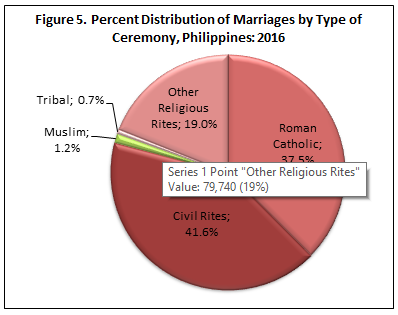
Filipino brides and grooms also marry other nationalities
There were 404,556 marriages (96.4% ) between Filipino grooms and Filipino brides while 15,072 (3.6% ) involved foreign nationals.
Among foreign nationals, the highest frequency of intermarriages involved Filipino grooms and Australians (317) followed by Americans (279), Canadians (162) and Chinese brides (157).
On the other hand, the highest numbers of intermarriages were between Filipino brides and American grooms (3,081). Other foreign nationals who married Filipino brides were Japanese (1,585), Australian (925), British (862), Korean (781) and Canadian (769). (See Table 6)
LISA GRACE S. BERSALES, Ph.D.
Undersecretary
National Statistician and Civil Registrar General
It could be noted that more brides and grooms aged 25-29 preferred to be solemnized in the Roman Catholic Church than any other types of marriage ceremony. (See Tables 5a and 5b)
